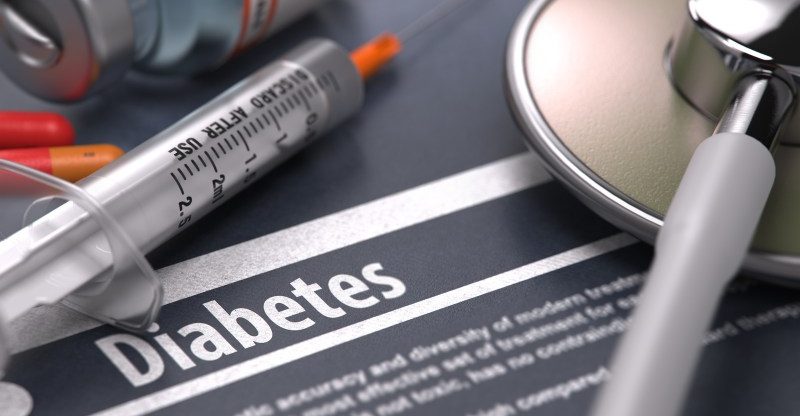16 Evidence-Based Ways to Prevent Diabetes
Are you one of the 84 million American adults with prediabetes?
Could you be part of the 25% of people with diabetes in this country who are unaware they have the disease?
Diabetes, a disease that occurs when blood sugar is too high, can cause a number of major health problems and should be treated.
Diabetes is also a disease that can be prevented with changes in lifestyle, diet, and activity level, and it is possible, in many cases, to reverse completely your Type 2 diabetes if you follow the proper guidelines.
Are you ready to make some changes to your life to treat your diabetes?
Our guide is here to help.
What is Diabetes?
Your body uses the glucose, or sugar, in the foods you eat as fuel.
After your digestive system breaks food down, your body release glucose into your bloodstream.
Insulin, which is a hormone produced in your pancreas, helps your body use glucose for energy by getting the sugars into your cells and out of your blood.
When you don’t have enough insulin, or when your body does not use it efficiently, the glucose stays in your blood, giving you high blood sugar, or diabetes.
Diabetes is a serious disease that should be treated carefully.
Diabetes is responsible for the majority of kidney failure and blindness in adults.
Those with diabetes are significantly more likely to develop heart disease, too.
Diabetes can cause nerve damage that ranges from mild to severe and can cause problems with circulation.
These two factors mean people with diabetes are more likely to require the amputation of a foot or leg.
Diabetes is currently listed as the seventh leading cause of death, responsible for over 70,000 deaths each year and playing a large role in many more.
Differences between Type 1 and Type 2 Diabetes
Type 1 diabetes occurs when your body cannot produce insulin.
Type 1 is generally diagnosed in young children or adolescents but can be diagnosed later in life.
Because the pancreas cannot produce the insulin their bodies need, Type 1 diabetics must take insulin in order to survive.
There is no cure for Type 1 diabetes, and controlling it is largely managed through injecting insulin and careful monitoring of your diet.
While not as common, you can develop Type 1 diabetes as an adult.
This is called Latent Autoimmune Diabetes of Adults, or LADA.
This variant of Type 1 diabetes develops slowly and will require more treatment as the disease worsens over time (1).
Type 2 diabetes occurs when your body produces less insulin than needed, or your body uses insulin inefficiently.
Type 2 is the most common type of diabetes, and the rate of incidence of Type 2 is rising.
You can be diagnosed with Type 2 diabetes at any age, but it is most commonly diagnosed in middle-aged or older people.
With the rise of obesity in our country, the diagnosis of Type 2 diabetes is rising and expected to continue doing so over the coming years.
Treatment of Type 2 diabetes varies, but generally includes monitoring of diet and exercise, and can include the use of medications to control blood sugar.
Are there Other Types of Diabetes?
There are a few less-common variants of diabetes.
One is gestational diabetes, which develops in some pregnant women.
Generally, gestational diabetes will resolve on its own after the baby is born, but occasionally women diagnosed with gestational diabetes will develop Type 2 diabetes later.
Other, rare forms of diabetes exist, including monogenic diabetes and cystic fibrosis-related diabetes.
These are not common and have their own treatment options.
What is Prediabetes?
There are many risk factors that doctors pay attention to when assessing your risk of becoming diabetic.
One that should be carefully monitored is your blood glucose or sugar level.
If you regularly have blood glucose levels that are elevated beyond the normal range, you have prediabetes.
Your body is either not producing enough insulin to handle the sugar in your blood, or your cells are using your insulin poorly which means that you have insulin resistance.
In either case, you can change many different aspects of your life to get your blood glucose levels back down into the normal range, removing you from the prediabetic category.
How Can I Prevent Diabetes?
In the vast majority of cases, Type 2 diabetes is preventable.
Treating diabetes is largely about making changes to lifestyle, including diet and exercise.
If you have been diagnosed with prediabetes, or if you have Type 2 diabetes and would like to reverse the effects of this disease, you can do so with changes to your behaviors.
Weight loss, increased activity, and quitting smoking are the three biggest changes you can make to prevent diabetes or treat Type 2 diabetes (2,3,4,5).
Our diabetes prevention guide provides you with concrete examples of changes you can embrace in your life that will greatly reduce your risk of developing Type 2 diabetes.
While you cannot undo factors such as genetics or past lifestyle choices, there is much you can do about your future decisions.
Make Different Lifestyle Choices
There are many different aspects of your life that can contribute to the likelihood that you will develop Type 2 diabetes.
Managing these can mean the difference between getting healthier and becoming sicker.
Lose Weight
Being overweight or obese is the number one risk factor associated with Type 2 diabetes.
The vast majority of those with Type 2 diabetes are either overweight or obese.
The extra weight and fat cells are added pressure to your body to use insulin properly and therefore control your glucose levels.
Of particular concern are those whose extra weight and fat tend to be in their upper body and mid-section.
This belly fat is known as visceral adipose tissue, and the accumulation of fat in these areas puts more strain on your internal organs.
Accumulating body mass in your abdomen has been shown to increase risks of death due to cardiovascular and cardiac diseases, as well as diabetes (6,7,8,9).
Throughout this guide, you will learn what to add and eliminate from your diet to help control your blood glucose levels and lose weight, as well as ways to increase your activity level.
All of these can assist you in losing weight.
Changes in your lifestyle that will help you reduce your weight can have a significant impact on your risk for developing Type 2 diabetes (10,11), and controlling your weight should become a top priority if you are looking to prevent its onset.
Quit Smoking
We already know that the dangers of smoking include developing heart disease, emphysema, and several different types of cancer, but did you also know that smoking increases your chances of developing Type 2 diabetes (12)?
Smokers are more likely to be overweight, and smoking increases the levels of inflammation in your body, both of which are precursors to diabetes.
The chemicals in cigarette smoke damage cells throughout your body, not just your lungs, making them less efficient at processes like removing sugar from your blood.
Whether you live with a smoker, smoke just a few, or smoke a pack or more a day, smoking significantly raises your risk factors for diabetes (13,14,15,16).
Quitting smoking can have extremely positive impacts on your overall health, including lowering your blood glucose levels.
Find a smoking cessation program, or speak to your physician about taking this important step toward better health.
Sleep Well
The link between sleep and diabetes has been known for some time.
When your blood sugar is high, your kidneys work hard to eliminate the extra glucose.
Those with high blood sugars generally urinate more, including at night, preventing them from getting restful sleep.
In addition to diabetes contributing to sleep loss, not sleeping well can also increase your risk of developing the disease.
When you are tired from lack of sleep, you often eat more to get more energy.
This can cause spikes in glucose levels.
By maintaining a more consistent diet that focuses on the gradual release of sugars, you are likely to feel better and sleep more soundly.
For those who are constantly sleep deprived, due to stress or other outside factors, you are placing your body in a state of constant stress, which can lead to prediabetes (17,18).
Your body can become insulin-resistant with prolonged sleep deprivation, so getting a good night’s sleep whenever possible will assist your body in resting and repairing appropriately at night.
See Your Doctor Regularly
Visiting your doctor regularly means you can monitor your risk factors for Type 2 diabetes and discuss preventative measures with your physician.
If you are already prediabetic, regular monitoring of your blood glucose will be important.
In addition, your doctor can discuss with you any other risk factors you may have, including being overweight, smoking, any family history of diabetes, having high blood pressure, having low levels of HDL (the good type of cholesterol), having high levels of triglycerides in your blood, a sedentary lifestyle, a history of heart disease or stroke, or a previous diagnosis of depression or Polycystic Ovary Syndrome (PCOS).
If you have several of these risk factors, you may be prediabetic and not know it.
If you already know you are prediabetic, you should look at the diagnosis as a call to action rather than an inevitable future diagnosis of Type 2 diabetes (19), and seeing your doctor regularly is a great step toward reversing your course toward diabetes.
Change Your Activity
In addition to changes in your diet, which are discussed below, increasing your activity level can greatly reduce your risk of Type 2 diabetes.
Helping your body to use more efficiently the fuel supplied by food is important to boosting insulin sensitivity and reducing overall blood sugar.
Work Out Regularly
Regular exercise is an important factor in helping to maintain a healthy weight.
When you exercise, your body’s cells become more sensitive to insulin, which means you need less of it to maintain your blood glucose level.
Moderately intensive exercise can increase your insulin sensitivity by 51%, while highly intensive exercise can raise your sensitivity as much as 81% (20).
But exercise must be performed regularly in order to have a real effect on blood glucose levels and insulin sensitivity.
All types of exercise are known to be helpful in reducing diabetic symptoms, including strength training, aerobic exercise, and interval training.
Whether you like to walk, swim, ride your bike, work out with weights, or join an exercise class, your body will enjoy many benefits from the regular exercise of at least 30 minutes per day, at least five days per week (21,22,23,24).
With so many options for exercise, experiment until you find ones you really like and can stick with to make regular movement a part of your health routine.
Avoid Sedentary Behaviors
Many of us have read headlines touting, “Sitting is the new smoking.”
There is a reason, though, that this type of bold claim is being made.
Those who are sedentary, meaning that you sit the majority of the day and get no or very little physical activity, are at vastly increased risk for diseases such as diabetes and heart disease (25,26).
Physical inactivity is known to increase your risk of developing certain types of cancer and contributes to mental health issues like depression and anxiety, as well as to elevated blood pressure and cholesterol levels.
People who are inactive or live a sedentary lifestyle are more likely to be overweight, to develop cardiovascular disease, and have decreased muscle mass.
All of these are risk factors for early death, and those who are inactive should make changes to their lifestyle to get more activity each day.
Make small changes to start, such as getting up and walking around every hour, and gradually increase your activity.
Walking 10,000 steps a day, or roughly 5 miles, is a great way to combat the effects of a sedentary job.
Reduce Your Stress Levels
When your body is under stress, it releases various hormones to help you deal with it.
Generally, these hormones are designed to trigger processes that give you more energy for mentally or physically dealing with the stressors in your life.
The release of these hormones raises blood glucose levels, and these stress-induced increases in insulin are usually not metabolized properly, leaving you with raised blood sugar.
A heightened or prolonged bout of stress can leave you chronically hyperglycemic.
Therefore, managing stress levels and finding ways to utilize the energy produced from the release of stress hormones is important to manage your Type 2 diabetes.
Ways to manage stress include deep breathing exercises, meditation to help you focus on more positive aspects of your life, exercise to release endorphins and use the extra energy your body is producing, and eliminating stress triggers whenever possible (27).
When stress is brought on by outside forces, such as work, you must prioritize your own health and manage your stress so that it does not have an adverse impact on your body.
Change What and How You Eat
Not only will changing your eating habits likely result in weight loss but knowing what and when to eat and drink can greatly assist in keeping your blood sugar levels consistent.
By making adjustments to your intake of carbs, simple sugars, processed foods, and sweetened beverages, you will support your body in its use of insulin, reducing your risk for Type 2 diabetes.
Reduce Sugar in Your Diet
Foods that contain high amounts of sugar and refined carbohydrates are not healthy for anyone but are especially problematic for those with prediabetes or those who have other diabetes risk factors.
When you eat these foods, your body has very little work to do to convert your food into glucose and release it into your bloodstream.
Your glucose levels rise, signaling your pancreas to release insulin.
When due to insulin resistance your body doesn’t deal effectively with these high sugar levels, your pancreas will release more insulin.
This can lead to higher blood sugar levels over time, leading to the development of Type 2 diabetes when your diet consistently contains these simple sugars.
Those who eat diets high in simple carbs and sugars have a 40% higher risk of developing diabetes than those who consume less of these types of foods (28).
When you replace simple carbohydrates and sugar in your diet with foods that release glucose more slowly into your blood, you reduce your risk of developing diabetes.
Foods that have a lower glycemic load are more slowly absorbed by your body, and your body is able to utilize the nutrition in them more steadily.
Exchanging sugary foods in your diet for these types of food will reduce your risk of Type 2 diabetes (29,30,31,32,33).
Eat Complex Carbs in Small Amounts
For those concerned with preventing diabetes, paying attention to your food’s glycemic load is very important.
While the glycemic index tells you how quickly a food is absorbed into your blood in the form of glucose, the glycemic load is more helpful information, as it tells you how many carbs are in a food and therefore how much energy (or sugar) it will deliver over time.
Foods with low to medium glycemic loads will deliver sugar more consistently over time, and won’t produce spikes in your blood sugar.
Complex carbohydrates, while offering a lower glycemic load, are still high in carbohydrates and therefore will deliver a great deal of sugar to your blood, if not consumed carefully.
Selecting a diet low in carbohydrates, such as a ketogenic diet, not only promotes weight loss, but low-carb diets also lower blood sugar levels and increase your cells’ sensitivity to insulin.
These combine to reduce your risk of diabetes (34,35,36,37,38).
Diets low in carbs are more beneficial for reducing the risk of diabetes than low-fat diets or other types of eating plans (37).
By decreasing your overall carb intake, including complex carbs, your blood sugar will remain steady throughout the day and your pancreas will produce less insulin.
Eat More Fiber and Whole Foods
Eating foods rich in dietary fiber has benefits for your overall weight, as well as the health of your digestive tract, or gut health.
High-fiber foods also help manage blood glucose and insulin levels, particularly in the elderly, the obese, and those with prediabetes (39,40,41,42).
Foods rich in soluble fiber, which dissolves in water, are released into the blood more slowly, leading to a more gradual increase in blood glucose (43).
Insoluble fiber also has a positive impact on blood glucose, but how this works is not known at this time (43,44).
Eating fiber-rich foods is beneficial for reducing your risk of developing Type 2 diabetes, and eating more whole-plant foods and few (if any) processed foods is a good way to increase your daily fiber intake.
Diets heavy in processed and packaged foods cause many problems, including obesity, heart disease, and Type 2 diabetes (45,46).
These foods are usually very high in sugars, sodium, additives, and fat, all of which are not part of a healthy diet.
Shifting the focus of your diet to whole plant foods, like fruits, vegetables, and nuts can reduce your risk of Type 2 diabetes by lowering your glucose levels, providing a steadier supply of glucose throughout the day, and helping you to maintain a healthy weight (46).
Monitor Your Portions
While eating less will assist you in losing weight, eating smaller portions at each meal can also have beneficial effects on your blood sugar levels.
Each large meal causes significant increases in blood glucose.
Eating smaller portions, particularly of foods with a high glycemic load, will keep your blood sugar at a steadier level and help reduce your risk of diabetes.
Portion reduction, in combination with eating healthier foods, can reduce your risk of developing diabetes by as much as 46% (47).
In fact, just reducing portion size for 12 weeks can significantly lower your blood sugar and insulin levels (48).
Drink Mostly Water
When considering ways to reduce your daily sugar intake, what you drink should be just as important as what you eat.
Drinking sweetened beverages or drinks naturally high in sugars will have the same impact as eating sweet foods.
Your blood sugar rises quickly, your body releases insulin, your cells don’t use the insulin efficiently, and you release more insulin.
By switching from sodas, juices, and other sweet beverages (including those with artificial sweeteners) to water, you reduce your risk of diabetes by providing the less glycemic load to your system (49).
High-sugar drinks are linked to increased incidences of both Type 2 diabetes and LADA.
If you drink more than two high-sugar drinks a day, you are at an increased risk of developing Type 2 diabetes, and your chances of developing LADA increase nearly 100% (50).
By increasing your water intake, you are supporting your body’s natural ability to control your blood glucose and respond to insulin more efficiently (51,52).
Drink a Small Amount of Alcohol
Recently, we have learned that drinking small amounts of alcohol not only plays a role in reducing the risk of heart disease but can also reduce the risk of Type 2 diabetes.
A small amount of alcohol increases your cells’ efficiency at absorbing glucose, which could decrease your risk of developing diabetes.
It is important that the amount of alcohol be kept low, with just one drink per day for women and two for men, as more can have the opposite effect intended for glucose conversion.
If you are not a drinker, there is no need to start, as changing other diet and exercise habits can have the same positive effects as alcohol on your diabetes risk (53,54,55,56,57).
Drink Some Coffee or Green Tea
Drinking caffeinated coffee or tea reduces your risk for Type 2 diabetes.
While it is unclear if it is the caffeine or other components of coffee that has the positive effects, it is clear that adding sweetener or other additives negates the positive influences of drinking coffee, so keep it simple.
Whether you are benefiting from the polyphenols (a type of antioxidant), or another compound, drinking coffee or tea daily can have positive effects for those who are at risk for diabetes (58,59,60,61,62).
Green tea contains other antioxidants that are known to increase your cells’ sensitivity to insulin, as well as reduce the release of glucose from the liver (63,64), so it is also a good alternative.
Remember to drink these in moderation, and still choose water as your primary beverage, though.
Get Plenty of Vitamin D
Our understanding of the role of Vitamin D in our bodies’ overall health is continuing to evolve, but there is clear evidence that those with low levels of Vitamin D are at greater risk for developing all types of diabetes, which tells us it is important for blood sugar control (65,66,67,68).
Many are not even aware that they are deficient in Vitamin D, but the condition is common, particularly in areas that do not receive much sunlight year-round.
Your body produces Vitamin D in your skin when exposed to sunlight, leading some to call it the “sun vitamin.”
It is common for those who live in northern latitudes, people who work at night, or anyone who otherwise doesn’t receive adequate sun exposure to be deficient in Vitamin D.
If your Vitamin D levels are lower than 30 ng/ml, you may consider taking a supplement.
Those at risk for diabetes see an improved function in their pancreatic cells with higher Vitamin D levels, resulting in glucose levels that are more normal (67,68).
Consider Natural Herbs
Two herbs that hold promise as natural treatments for diabetes are curcumin and berberine.
Curcumin can be found in turmeric, and berberine can be found in a number of plants, including barberry, Oregon grape, Chinese goldthread, and yellow root.
Curcumin, a natural anti-inflammatory, may assist those with prediabetes, decrease insulin resistance, and slow or stop diabetes progression (69,70,71,72).
Curcumin seems to work because it increases insulin sensitivity, as well as promotes improved the functioning of the pancreas, which produces insulin.
Berberine is also known for its anti-inflammatory properties and has recently been shown to lower blood sugar in those with Type 2 diabetes (73,74,75,76).
Berberine may be as effective at controlling glucose levels as traditional diabetes medications, such as metformin.
Because berberine has not been studied for these benefits, though, it should not be used without discussing it with your physician.
Join a Diabetes Prevention Program
Making significant lifestyle changes can be difficult, and sustaining those changes over time can be even harder.
Many who attempt to control their diabetes risk factors or make healthier lifestyle choices find benefit from support programs.
The Centers for Disease Control and Prevention (CDC) has approved diabetes prevention programs that can assist those with prediabetes in making lifestyle changes in order to prevent the onset of Type 2 diabetes.
In addition to providing you with information and guidance on exercise, nutrition, and smoking cessation, these programs provide an important element of emotional support, which can be very effective when making changes a permanent part of your life.
Getting help from others can be an important step toward your long-term health and well-being.
There are both online programs and face-to-face options that fit many different needs (77,78).
Conclusion
Type 2 diabetes is a largely preventable disease.
By making changes to your life that lead to better health, lower weight, and a more active life, you will be greatly reducing your chances of developing it.
Changing behaviors can be difficult, but these healthy lifestyle choices will lead to a longer, healthier life for those who embrace them.
FDA Compliance
The information on this website has not been evaluated by the Food & Drug Administration or any other medical body. We do not aim to diagnose, treat, cure or prevent any illness or disease. Information is shared for educational purposes only. You must consult your doctor before acting on any content on this website, especially if you are pregnant, nursing, taking medication, or have a medical condition.
HOW WOULD YOU RATE THIS ARTICLE?







Must starchy veggies be totally excluded from the menu? And what fruits are safe to eat?
Hi Casey,
No need to completely eliminate starchy vegetables (you can still eat complex carbs in small portions), but I would definitely try to substitute them by non-starchy veggies. As for fruits, you can eat lemons, raspberries, kiwis and blackberries, as well as other low-sugar fruits.
This article is great and full of valuable advice! I used to lead not a very healthy lifestyle, frankly speaking, there was nothing healthy in my life: no physical activity, lots of processed foods, lack of sleep and proper rest…All changed when I was told I almost had diabetes at the age of 25. I realized I needed to change my life completely. That was sooo difficult! But step by step I did everything written in this article, and I saw the results just after several months! My blood sugar test was much better. Gradually, I returned my health to myself.
I’ve written all this to tell everyone who’s afraid to make changes that it’s possible to avoid diabetes, to be healthy and full of energy. This post is a guide to a new life without diabetes!
Great job, Shirley!
Thank you for this article! I’ve read many of those recommending how to prevent and treat diabetes but this one is the most comprehensive and trustworthy.
Thanks! 🙂
Can diabetes develop in a seven-year-old child? Considering the fact that the kid is overweight and eats predominantly junk food?
I’m really worried that my nephew whom I’m talking about will get diabetes at a very young age and I’m trying to convince my sister to change his lifestyle. She thinks there’s no reason for concern…
Hi Renee,
Children can develop Type 1 diabetes, but it is not related to unhealthy lifestyle. While exact reasons are unknown, researches say that factors like genetics and environment can have a role. Keeping that in mind, your sister shouldn’t eat a lot of junk food.
Are all protein sources good for the people with diabetes? Is red meat safe and how much of it is okay to eat?
Can I have type 2 diabetes not being overweight? Does genetic factor matter?
Does it matter what type of activity I choose? Which one is better: cardio or strength exercise? Does stretching help?
Nothing new here. Yes, lose weight, exercise more, watch your sugars and don’t stress. We’ve known this for how many decades?
Yes,
And yet, people disregard it until they become pre-diabetic or develop other issues…
In every guide I come across, it’s recommended to avoid stress. But it’s easy to say, not to achieve. My life is full of stress, I know it affects my health enormously but there’s nothing I can do. Neither meditation nor breathing exercises help me…If I take medications to manage my stress, will this work for preventing diabetes?
Can a person with the prediabetes drink alcohol occasionally and in moderation? Which types of alcohol are allowed? Beer? Wine? Gin? How much alcohol a month is okay and safe to drink?
Hi Aleisha,
Alcohol affects your blood sugar levels, so it is advisable to cut down drastically if you are pre-diabetic. It doesn’t mean that you should just stop drinking completely, just drink moderately on big occasions.
I’m obviously in the prediabetes condition: I lack activity, have lots of extra pounds and smoke. I really want the changes in my lifestyle but it’s too hard for me, especially quitting smoking. Can the people in my situation use conventional remedies for quitting this habit like nicotine gum and patches?
Sure,
As a former smoker myself, I know it might be very difficult to quit. So try all conventional methods you can find.
Good luck!